
Botenlauben Castle is a ruined castle in Reiterswiesen, a district of the Bavarian spa town of Bad Kissingen.

Botenlauben Castle is a ruined castle in Reiterswiesen, a district of the Bavarian spa town of Bad Kissingen.
The castle was home of the minnesinger and crusader Otto von Botenlauben and his wife Beatrix de Courtenay (founders of the Frauenroth cloister), who both stayed from 1220 to 1242. The exact year the castle was built is unknown, but it is generally accepted to be from around 1180. The name probably comes from the words 'Boto' (name of the architect) and Laube (meaning residence). In 1234, the castle came under the control of the Bishopric of Würzburg, under Bishop Hermann I von Lobdeburg. In 1242, the castle became the administrative centre of the diocese's offices. It was eventually moved to Ebernhausen in 1525 following the German Peasants' War, and then completely dissolved in 1670.
During the Peasants' War, the castle fell victim to peasants from Aura an der Saale. Legend has it that the peasants were admitted to the castle by its perfidious cook, who, however, was not rewarded with gold coins but blinded and killed by the peasants; since then, his ghost wanders about the castle in stormy nights chopping on his chopping board.
Following the failed peasants' revolution, they were forced to rebuild the destroyed castle. In 1553, during the 'Margravial war', the castle was destroyed for the last time, and since the 17th century has served as a quarry to the residents of Reiterswiesen.
Around 1830, this situation came to an end when people began to take an interest in the Romantic period and the Middle Ages (embodied definitively in 1881 when the ‘Botenlauben club’ was founded). From the beginning, the guiding principle was always to make the castle into a tourist attraction, which became more of an historical interest at the start of the 20th century. In the second half of the century, the castle underwent some restoration work. Today, life in the castle during the Middle Ages is remembered and re-enacted each year in September with the 'Burgfest'.

Bad Kissingen is a German spa town in the Bavarian region of Lower Franconia and seat of the district Bad Kissingen. Situated to the south of the Rhön Mountains on the Franconian Saale river, it is one of the health resorts, which became famous as a "Weltbad" in the 19th century. In 2021, the town became part of the transnational UNESCO World Heritage Site under the name "Great Spa Towns of Europe", because of its famous mineral springs and its architecture exemplifying the popularity of spa resorts in Europe during the 18th through 20th centuries.

The Franconian Saale is a 140 km long river in Bavaria, Germany. It is a right-bank tributary of the Main, in Lower Franconia. It should not be confused with the larger Saxon Saale, which is a tributary of the Elbe River.

Marienberg Fortress is a prominent landmark on the left bank of the Main river in Würzburg, in the Franconia region of Bavaria, Germany. The mighty Fortress Marienberg is a symbol of Würzburg and served as a home of the local prince-bishops for nearly five centuries. It has been a fort since ancient times. Most of the current structures originally were built in Renaissance and Baroque styles between the 16th and 18th centuries. After Gustavus Adolphus of Sweden conquered the area in 1631 during the Thirty Years' War, the castle was reconstructed as a Baroque residence. After it ceased to serve as residence of the Bishops of Würzburg, the fortress saw repeated action in the wars of the late 18th and 19th centuries. Festung Marienberg was severely damaged by British bombs in March 1945 and only fully rebuilt in 1990. Today, it houses two museums.

The Harzburg, also called Große Harzburg, is a former imperial castle, situated on the northwestern edge of the Harz mountain range overlooking the spa resort of Bad Harzburg in Goslar District in the state of Lower Saxony, Germany. It was erected from 1065 to 1068 at the behest of King Henry IV of Germany, slighted during the Saxon Rebellion in 1073-75, and a century later rebuilt under Emperor Frederick Barbarossa and his Welf successor Otto IV, who died here in 1218.

The Hochburg is a castle ruin situated between the city of Emmendingen and the village of Sexau in the region of Baden, located in the southwest of Germany. It was presumably built in the 11th century and was originally known as castle Hachberg. The line of nobles known as the Margraves of Baden-Hachberg most likely derive their name from this castle and before it was razed by the French it was the second largest fortification in Baden.
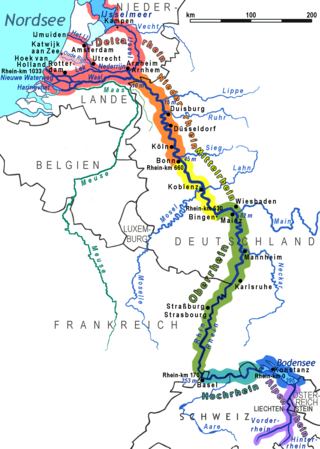
Between Bingen and Bonn, Germany, the river Rhine flows as the Middle Rhine through the Rhine Gorge, a formation created by erosion, which happened at about the same rate as an uplift in the region, leaving the river at about its original level, and the surrounding lands raised. This gorge is quite deep, about 130 metres (430 ft) from the top of the rocks down to the average water-line.

Gemünden am Main is a town in the Main-Spessart district in the Regierungsbezirk of Lower Franconia (Unterfranken) in Bavaria, Germany and lies roughly 40 km down the Main from Würzburg. Gemünden has around 10,000 inhabitants.
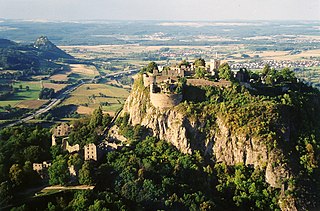
Hohentwiel is an extinct volcano in the Hegau region of Baden-Württemberg in southern Germany The mountain is west of the city of Singen and 20 miles (30 km) from Lake Constance.

Otto von Botenlauben or Botenlouben, the Count of Henneberg from 1206, was a German minnesinger, Crusader and monastic founder.

The House of Henneberg was a medieval German comital family (Grafen) which from the 11th century onwards held large territories in the Duchy of Franconia. Their county was raised to a princely county in 1310.

Kirchheim or Kirchheim in Schwaben is a municipality and a market town in the district of Unterallgäu in the region of Swabia (Schwaben) in the south-west of Bavaria, Germany. The town was greatly influenced by the Fugger family. North-east of the town lies the Augsburg Western Woods Nature Park.

Barchfeld is a village and a former municipality in the Wartburgkreis district of Thuringia, Germany. Since 31 December 2012, it is part of the municipality Barchfeld-Immelborn.

St. Trudpert's Abbey is a former Benedictine monastery in Münstertal in the southern Black Forest, Baden-Württemberg, Germany, now the principal house of the Sisters of St. Joseph of St. Trudpert.
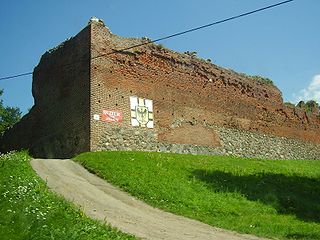
Starostwo of Draheim or Drahim was a starostwo of the Polish kingdom from the 15th century, seated in Draheim. Pawned to Brandenburg-Prussia in 1657, it was directly incorporated into the Kingdom of Prussia in 1772 as Amt Draheim and the Town of Tempelburg.
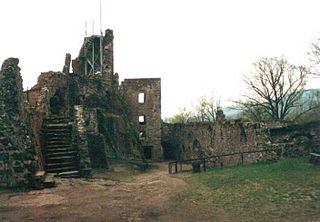
Hohnstein Castle is one of the largest and best-preserved castle ruins in Germany and is located near Neustadt in the vicinity of Nordhausen in Thuringia.
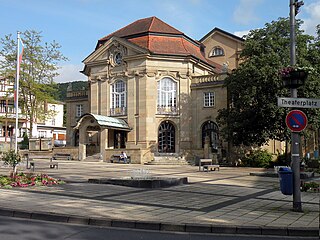
The Kurtheater Bad Kissingen is a theatre in the spa town Bad Kissingen in Bavaria, Germany.

Spa architecture is the name given to buildings that provide facilities for relaxation, recuperation and health treatment in spas. The architecture of these buildings is called "spa architecture" even though it is not a uniform architectural style, but a collective term for a genre of buildings with a spa function.
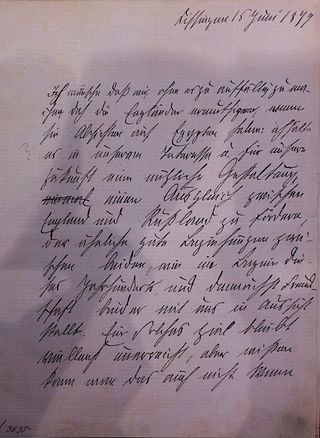
The Kissingen Dictation is a diplomatic file created in Bad Kissingen by the German Chancellor Otto von Bismarck during the summer of 1877. It contains the principles of his foreign policy.

The Battle of Kissingen was a battle between Bavarian and Prussian troops on 10 July 1866 during the Austrian-Prussian War in and around the town of Kissingen in Bavaria. It was part of the campaign of the Main and ended with a victory of the Prussians.

The King Ludwig Oak is an oak tree recognised as a natural monument in the Staatsbad Brückenau, a state-run spa and park two kilometres (1.2 mi) west of Bad Brückenau in the German state of Bavaria. The German Tree Archive counts the oak among the trees of national importance.